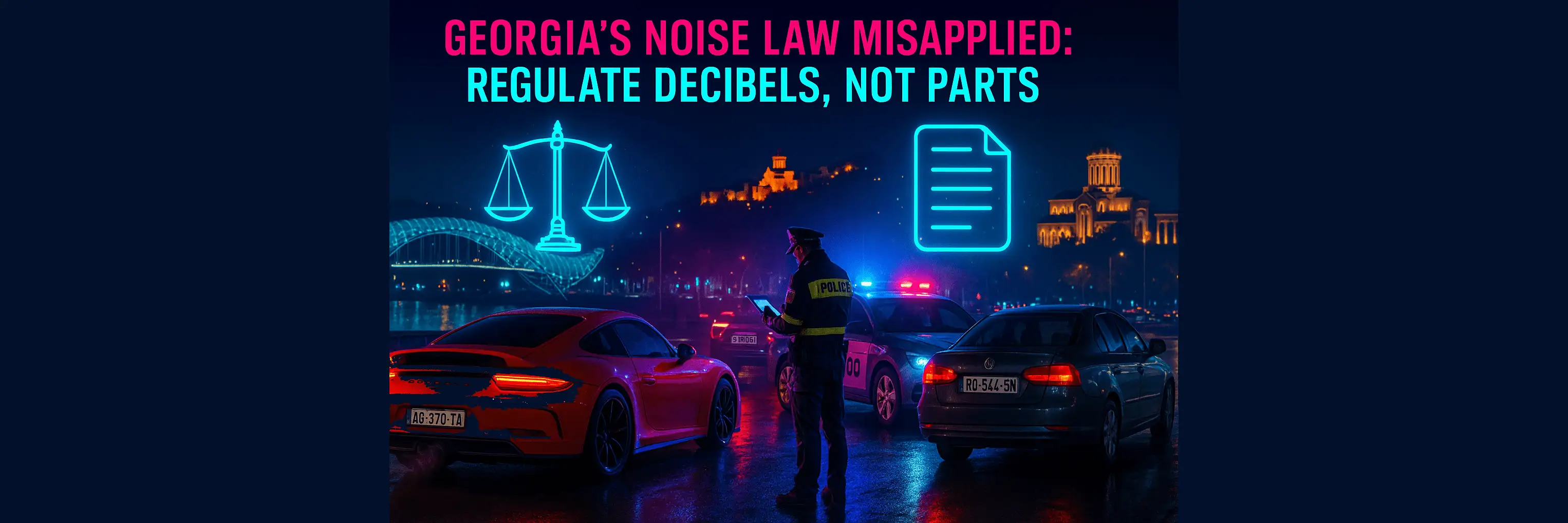The Ministry of Internal Affairs of Georgia has intensified its crackdown on noisy vehicles, which has led to mass fines and vehicle confiscations. However, lawyers and drivers argue that the enforcement is based on the misapplication of the law, creating a legally ambiguous and financially burdensome situation for citizens, which is exacerbated by a complex socio-political climate.

Problem Definition: What Issue Should the Law Address?
We all agree that vehicular noise during night hours is a significant problem that greatly disturbs the public. The laws under our consideration must be evaluated in relation to this specific goal. It is noteworthy that we have two relevant laws (both of which existed previously but have since been amended).
The Law on Noise That Doesn't Work (Article 119, Part 3⁴ of the Code of Administrative Offenses)
This part of the code directly establishes liability for driving a vehicle that produces noise exceeding the "norm established by the legislation of Georgia."
The fundamental flaw: The law is practically unenforceable because, to this day, no subordinate normative act has been passed to establish specific permissible noise limits. Without this, the law's requirement is abstract and creates a legal dead end. Consequently, this law, which is meant to directly regulate the noise problem, is effectively "impotent."
The Law That Is Being Misapplied (Article 119, Part 5 of the Code of Administrative Offenses)
This is the provision that has become a major problem and a subject of debate. It prohibits the driving of a vehicle that has been arbitrarily modified. A violation is defined as a structural change that does not comply with road safety requirements and/or the manufacturer's standards.
Analysis: Why is this approach fundamentally flawed?
a) Problem with the Law's Purpose and Logic:
The law contains no mention of noise. Its declared purpose is safety.
Among the factors that could be grounds for a fine (fuel tank, chassis, muffler, etc.), only the muffler could theoretically be a source of noise.
If a vehicle's structural modification is so significant that it creates safety risks, it should be flagged and failed during the periodic technical inspection. This raises the question: what problem does this law actually solve? It only addresses theoretical cases where a vehicle has passed technical inspection but still violates safety norms.
b) Violation of Fundamental Legal Principles:
Violation of the Principle of Legal Foreseeability: The phrase "does not comply with the manufacturer's standards" is extremely vague, giving patrol officers the discretion to make arbitrary decisions.
Violation of the Principle of Equality: A new, factory-loud sports car is legal, while an older vehicle with a high-quality, non-original (and possibly quieter) muffler is in violation. The focus is not on the actual outcome (noise) but on a formal characteristic (origin).
The Vicious Cycle: Enforcement Practices and Their Social Consequences
Since the law that directly regulates noise is ineffective, the Ministry of Internal Affairs is using the second law, which is entirely unrelated to noise, to seemingly "solve" the noise problem. This creates a vicious cycle with severe socio-economic consequences.
A financial trap for citizens: The fine, impoundment fees, and modification costs place a heavy burden on the driver. This expense is typically less than hiring a lawyer and spending years in court. Therefore, despite a sense of injustice, most people prefer to comply and pay the fine.
Restricted Access to Justice and Suppression of Protest:
Thanks to our government, specifically the so-called "transparency" or "Russian law," the resources of non-governmental organizations that provided citizens with free legal aid to appeal such contestable fines have been virtually eliminated.
Furthermore, it must be understood that protests that do not pose a threat to the government are ignored. Meanwhile, protests that are considered a threat are effectively banned in the country due to the 5,000 GEL fines.
These factors combine to create a system where the citizen is left practically alone to face the state's questionable decisions, with no effective mechanisms to resist.
Final Conclusion
The current situation creates a vicious cycle where a real problem (noise) is being addressed with the wrong legal instrument. The state's objective should not be what is installed on a vehicle, but how it operates. The solution is to establish specific, measurable noise norms and to equip patrol officers with the appropriate technology for enforcement.
Until this happens, the law will remain an instrument of injustice, subjective enforcement, and a violation of citizens' rights.